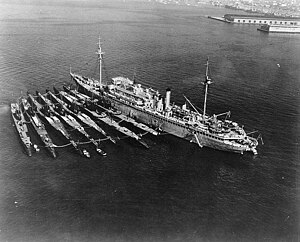
| |
| Class overview | |
|---|---|
| Builders | Portsmouth Naval Shipyard, Mare Island Naval Shipyard, Electric Boat Company[2] |
| Operators | |
| Preceded by | S class and T class[1] |
| Succeeded by | Porpoise class[1] |
| Built | 1921–1934[2] |
| In commission | 1924–1945[2] |
| Completed | 9[1] |
| Lost | 1[1] |
| Retired | 8[1] |
The V-boats were a group of nine United States Navy submarines built between World War I and World War II from 1921 to 1934 under authorization as the "fleet boat" program.
The term "V-boats" as used includes five separate classes of submarines: large, fast fleet submarines (V-1 through V-3), large long-range submarines (the minelayer V-4 and two submarine cruisers V-5 and V-6) and three medium-sized submarines (V-7 through V-9).
The successful fleet submarines of World War II (Tambor class through Tench class) were descended from the last three, especially V-7, though somewhat larger with pure diesel-electric propulsion systems.
Originally called USS V-1 through V-9 (SS-163 through SS-171), in 1931 the nine submarines were renamed Barracuda, Bass, Bonita, Argonaut, Narwhal, Nautilus, Dolphin, Cachalot, and Cuttlefish, respectively. All served in World War II, six of them on war patrols in the central Pacific. Argonaut was lost to enemy action.
- ^ a b c d e Schlesman, Bruce; Roberts, Stephen S. (1991). Register of Ships of the U.S. Navy, 1775–1990: Major Combatants. Westport, Connecticut: Greenwood Press. pp. 265–268. ISBN 0-313-26202-0.
- ^ a b c Friedman, Norman (1995). U.S. Submarines Through 1945: An Illustrated Design History. Annapolis, Maryland: United States Naval Institute. pp. 285–304. ISBN 1-55750-263-3.